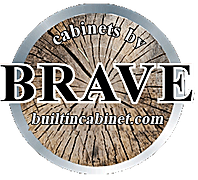The ABC's of Cabinet Terminology
-
Accessories:
Supplemental parts of the cabinet referred to as "bells and whistles." Also any components such as rollouts, pullouts, tilt-outs, hardware, etc.
-
Adjustable shelves:
Movable and removable shelves that can be placed in a wide range of layouts using shelf pins inserted into pre-drilled holes.
-
Base Cabinet:
Any cabinet type designed to install directly on the floor. It can feature doors, drawers, open shelves or a combination.
-
Bead Board:
Panels with vertical grooves to give a decorative appearance.
-
Blind Corner:
Any cabinet type, upper or lower, designed to install into a corner of a room. Another cabinet will install directly adjacent to it hiding the blind portion. This gives access to an otherwise dead corner providing more storage.
-
Concealed Hinge:
A hinge that is attached to the back of the door and to the inside of the cabinet box that is not visible from the outside of the cabinet. All our cabinets feature concealed hinges.
-
Corbel:
An architectural or decorative element used as a support mechanism for mantels, bar tops, shelves etc.
-
Crown Molding:
Decorative molding applied to the top of upper wall cabinet to provide a finished or decorative look.
-
Counter top:
The horizontal panel that lays flat on the base cabinet.
-
Dado:
A machined groove in a flat panel surface made to accept another panel.
-
Dovetail:
A joinery method used for joining two perpendicular parts, commonly used for making very strong joints in wooden drawer boxes. One part is machined with inverted “V” shaped projections (dovetail profile) and fitted into another part that is machined with the opposite “V” shaped cutouts.
-
Drawer Front:
Finished front panel of a drawer.
-
End Panel:
The outside vertical cabinet member that supports the horizontal parts. Often referred to as cabinet side panels, sides or ends.
-
Face Frame:
The supporting wood frame attached to the front of the cabinet box to give it structural rigidity and provide mounting support for doors and drawers.
-
Fillers:
Fillers are used between kitchen cabinets or near a wall at the end of the cabinets to cover gaps or as a decorative accents.
-
Fixed shelves:
Shelves that are constructed into the kitchen cabinet. They cannot be moved and provide added stability to the cabinet.
-
Framed Construction:
Cabinet box that has a face frame. It resembles a flat, empty picture frame attached to the front. Doors are secured to this frame.
-
Full Access Drawer Guide:
Cabinet drawer glides that allow the drawer to be extended to the back of the drawer.
-
Full Overlay:
Door styles that allow approximately 3/16” of face frame exposed around the sides, tops and bottoms of the doors. Wall cabinets have 7/16” exposed at the tops and bottoms of the doors.
-
Inset Drawers and Doors:
A framed cabinet with door and drawer fronts set “inside” of the frame itself. The frame is not covered by any portion of the door and/or drawer. The finished design achieves a “custom furniture” look.
-
Knob:
A hardware item, typically round in shape, attached to doors and drawers for function and decoration.
KnotA hard node in any wood species where a branch once grew.
-
Light rail:
Decorative moulding usually applied to the bottom of wall cabinets providing a finished look. Specifically designed to help mask the installation of under cabinet lighting.
-
MDF (Medium Density Fiberboard:
A composite wood panel made by reprocessing wood fibers to produce a flat stable panel that can be used in laminating or finishing.
-
Melamine:
A slick plastic-like material used to cover a substrate of particleboard or MDF. This material is popular because it is durable and easy to clean.
-
Miter:
A joint made by fitting together two angled pieces to form a right angle.
-
Molding:
A strip of material with a profile cut on the facing edges, used for trimming.
-
Onlay:
A decoratively carved wood ornament applied to cabinet surfaces. Used to embellish the design. Sometimes referred to as an appliqué.
-
Plywood:
A construction material made of thin layers of wood glued and pressed together.
-
Pulls, Knobs and Handles:
Pieces of hardware attached to a kitchen cabinet door or drawer front, used to open the cabinet and enhance the appearance.
-
Rail:
The horizontal pieces of frames, such as face frames and door frames.
-
Raised Panel:
A term used to describe a door style where a thick center panel is machined to be flush with the door frame, thus giving the depth appearance by the sloping “raise” of the panel.
-
Scribe Moulding:
A generic piece of moulding, usually 1/4” thick and up to 1” wide, for the purpose of trimming and concealing any discrepancy where the cabinet meets a wall.
-
Stain:
A finish applied to natural wood cabinets to enhance color and add protection.
-
Stile:
The vertical pieces of frames, such as face frames and door frames.
-
Thermofoil:
A tough, scratch resistant rigid vinyl that is thermally formed and sealed to MDF to provide a strong, durable surface, resistant to most household wear.
-
Toe Kick:
A term used to describe the recessed cut out area at the bottom of base, tall and vanity cabinets. It is also referred to as a toe space. Finished material attached to the cabinet toe space is referred to as “Toe Kick” or “Toe Space Cover”. Our kitchen and closet cabinet have toe kicks. Our standard built-in do not because you typically do not stand at it.
-
Veneer:
Thin sheets of wood which are bonded to a wood product to give a finished look.




